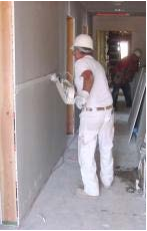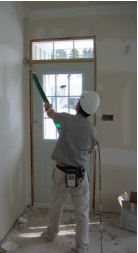The problem
- Tasks required to finish drywall manually, like mudding and taping, demand high forces from the upper limbs and trunk in awkward positions.
- Awkward postures, such as bent wrists, back flexion or back twisting are repeated while finishing drywall and result in an increased risk of hand, wrist, shoulder and back fatigue or injury.

Finishing drywall using traditional mudbox
One solution
- A pneumatic drywall finishing tool uses an air compressor to provide the pressure required to force the drywall compound through the flat and corner-finishing heads of the mud applicator. With the compressor generating the force, hand pumping the compound is eliminated and the high forces generated by the upper body are substantially reduced.
- The use of pneumatic finishing tools also reduces the frequency and duration spent in awkward postures, as well as the force required in these awkward postures.

Finishing drywall using pneumatic drywall finishing system
How it works
- An air compressor forces the drywall compound from the hopper into a tube, eliminating hand pumping.
- When the trigger on the tool is pressed, the air pressure sends the compound through the head of the tool evenly, giving the same quality of application that manually operated finish boxes do.
- The pneumatic drywall finishing tool applicator needs to be attached to the hopper via an airline while in use. The tool also requires access to an electrical outlet to power the compressor.
Benefits
- The replacement of manual drywall finishing tools with the pneumatic drywall finishing system will likely reduce injury. The results from a case study indicate workers are less fatigued and experience less discomfort while finishing drywall using the pneumatic drywall system compared to the manual tools.
- With the reduction in awkward postures and elimination of high forces required to manually pump compound into the applicator, the risk of arm and back injuries are reduced.
- Productivity is also expected to improve using the pneumatic drywall finishing system after workers have acclimatized themselves with the equipment. Study results indicate that workers felt they performed finishing tasks faster than they did using traditional finishing boxes. The study did note that the learning time was approximately two months to become proficient using the pneumatic tool.
Limitations
- The air and electrical lines may restrict work zone area and movement.
- The pneumatic system also takes longer to move, set up, and clean as compared to hand finishing equipment. Therefore, it may not be as practical for small finishing jobs.
For more information
- Products related to this solution are described at the Center for Construction Research and Training (CPWR).
- Products may also be found on the internet using the following search terms: “pneumatic drywall finishing.”
- Local contractor tool and equipment suppliers or rental companies may be another source of information on products.
- For general information on this solution, call the Infrastructure Health & Safety Association at 416-674-2726 or 1-800-781-2726.